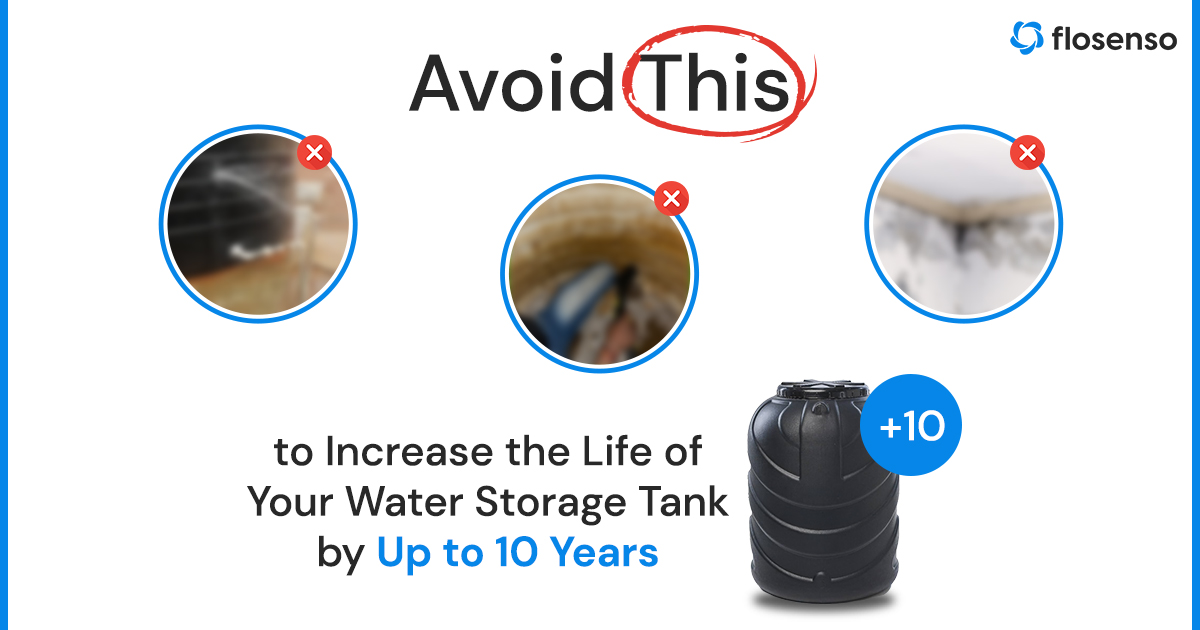Did you know that improper maintenance can cut your water storage tank’s lifespan in half? For businesses and households alike, water storage tanks are a critical resource for reliable water supply. A whopping 40% of water storage tanks in Indian households suffer from preventable issues like leaks and overflow. Treat it right, and you’ll enjoy a stress-free water supply for years to come.
This guide is here to help you ensure your water storage tank lasts up to 10 years longer. With the right maintenance practices and smart choices, you can protect your investment while reducing environmental impact.
Why your water tank needs special care
Your water storage tank for home or business endures a lot with exposure to the elements, constant pressure changes, and contaminants. Neglecting proper care leads to wear and tear, leaks, and even contamination risks.
However, the good news is that small, proactive measures can make a huge difference. Here is a list of things you need to keep checking on and create a maintenance routine that works.
What to do for a healthy tank life?
Studies show that 70% of tank owners overlook basic maintenance steps. These sneaky little mistakes might be sabotaging your tank’s lifespan.
1. Do not miss regular inspections
Skipping regular check-ups is like driving your car without ever looking under the hood. You may not notice small cracks or rust spots until it’s too late.
What to check during inspections:
- Exterior surface – Look for cracks, rust, or damage caused by weather exposure.
- Interior lining – Inspect for signs of corrosion or flaking.
- Seals and fittings – Ensure there are no loose parts or leaks around joints.
- Overflow systems – Confirm they are functioning properly to prevent water damage.
A simple monthly check-up can catch potential issues early, saving you from costly repairs down the line.
2. Avoid using hard water without treatment
Hard water is a silent tank destroyer. The high mineral content causes scaling inside your water tank, reducing its capacity and efficiency over time.
How to tackle hard water:
- Install a water softener – This removes excess minerals before they enter your tank.
- Flush regularly – Flushing the tank every six months clears out sediment buildup.
- Descaling solutions – Use safe chemical treatments specifically designed for water tanks.
By addressing hard water issues, you’ll keep your tank in top shape while protecting downstream appliances.
3. Do not compromise with tank cleanliness
A dirty tank is a breeding ground for bacteria and algae, which can compromise your water quality and damage the tank. Regular cleaning is a non-negotiable step.
Steps for effective cleaning:
- Drain the tank completely to remove standing water.
- Scrub the interior with a soft brush and eco-friendly cleaning solution.
- Rinse thoroughly to eliminate any residues.
- Let the tank dry before refilling it with fresh water.
Aim to clean your home water tank at least twice a year, or more frequently in areas with higher contamination risks.
4. Stop overloading your tank beyond its capacity
Overfilling your tank might seem harmless, but it can weaken the structure and lead to cracks or leaks.
Tips to prevent overloading:
- Know your tank’s capacity – Check the manufacturer’s manual for exact limits.
- Use an automatic water level controller – These smart devices ensure the tank fills only to its safe limit.
- Educate staff or household members – Ensure everyone knows how to monitor water levels correctly.
With proper capacity management, you’ll extend your tank’s life and prevent unnecessary wear.
5. Never miss checking external factors
Your water storage tank is exposed to environmental factors like UV rays, temperature fluctuations, and pests. Ignoring these risks can accelerate wear and tear.
How to protect your tank:
- Install UV-resistant covers – These shields prevent damage from sunlight.
- Use insulation – Protect your tank from extreme heat or cold.
- Pest-proofing – Seal any gaps to keep rodents or insects from nesting near your tank.
A few simple protective measures can go a long way in safeguarding your tank against the elements.
6. Don’t overlook water quality management
A survey revealed that 30% of tank damage is linked to poor water quality. The quality of water entering your tank directly impacts its longevity. Contaminants like silt, debris, and chemicals can corrode the interior and affect water safety.
How to maintain water quality:
- Install pre-tank filters – These trap sediments and debris before water enters the tank.
- Test water regularly – Check for pH levels, mineral content, and bacteria.
- Flush out sediment – Periodically drain a small amount of water from the bottom of the tank.
Clean water equals a healthy tank and better safety for you and your household or business.
7. Get the repairs done timely
A small leak today can turn into a major structural issue tomorrow. Addressing repairs promptly is critical for extending your tank’s life.
Signs it’s time for repairs:
- Unusual noises – Gurgling or hissing sounds may indicate a pressure issue.
- Visible damage – Cracks, rust, or bulges need immediate attention.
- Water discoloration – Brown or murky water suggests contamination.
Hire a professional to assess and fix major issues, especially if the damage is structural.
8. Stop the overflow with smart solutions
Did you know that an overflowing tank can waste up to 200 liters of water a day? That’s enough to meet a family’s daily needs! Smart technology can help you with water tank maintenance and save resources.
Top tech tools for tank care:
- Automatic water level controllers – These devices prevent overflows and manage water efficiently.
- Smart sensors – Monitor water levels, pressure, and temperature remotely.
- Mobile apps – Receive real-time alerts about tank conditions.
By incorporating smart technology, you’ll streamline maintenance while staying ahead of potential problems.
9. Ensure environmental responsibility
A well-maintained tank isn’t just about saving money, it’s also about sustainability. Regular care reduces water wastage and minimizes the need for replacements, cutting down on resource consumption.
Eco-friendly practices:
- Harvest rainwater – Reduce reliance on external water sources.
- Stop water wastage – Don’t let tanks overflow and taps leak.
- Choose durable materials – Invest in tanks made from recyclable, long-lasting materials.
Your small efforts can make a big difference for the environment.
Protect Your Water Tank, Protect Your Investment
Taking care of your water storage tank doesn’t have to be overwhelming. By avoiding common mistakes and adopting a proactive approach, you can significantly extend its life while ensuring clean, safe water for your business or household. Whether it’s regular cleaning, leak inspections, or integrating smart technology, every step you take will contribute to extending the lifespan of your water tank.
Pioneering Sustainable Solutions
Take care of your water tank maintenance with the Flosenso automatic water level controller. Designed to simplify water management, this smart device monitors and maintains optimal water levels, preventing overflows and reducing wear on your tank. With features like energy efficiency and real-time water level alerts on your smartphone, it’s the perfect addition to your home water tank setup. The smart technology and easy installation make it the perfect partner for your water storage tanks. Our IoT-based product is designed to optimize water usage, reduce wastage, and save energy, making it the perfect choice for environmentally conscious individuals and businesses.
Make a smart choice with Flosenso, because your water tank deserves the best care to avert future problems. Connect now to know how Flosenso can revolutionize your water tank maintenance and extend the life of your storage system.
Get your Flosenso. Save your water storage tank and the environment!











